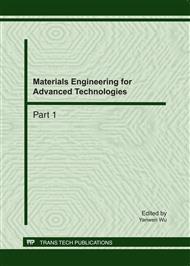[1]
Anil Kumar Anal and Harjinder Singh: Recent advances in microencapsulation of probiotics for industrial applications and targeted delivery. Trends in Food Science & Technology Vol. 18 (2007), p.240.
DOI: 10.1016/j.tifs.2007.01.004
Google Scholar
[2]
Sophie Houard, Michel Heinderyckx, Alex Bollen. Engineering of non-conventional yeasts for efficient synthesis of macromolecules: the methylotrophic genera. Biochimie Vol. 84(2002), p.1089.
DOI: 10.1016/s0300-9084(02)00011-1
Google Scholar
[3]
Carina Krüger, Yanzhong Hu, Qiang Pan, Harold Marcotte, Anna Hultberg, Dipu Delwar, Philip J. van Dalen, Peter H. Pouwels, Rob J. Leer, Charles G. Kelly, Craig van Dollenweerd, Julian K. Ma & Lennart Hammarström. In situ delivery of passive immunity by lactobacilli producing single-chain antibodies. Nat. Biotechnol. Vol. 20(2002).
DOI: 10.1038/nbt0702-702
Google Scholar
[4]
Sofie Termont, Klaas Vandenbroucke, Dirk Iserentant, Sabine Neirynck , Lothar Steidler, Erik Remaut, and Pieter Rottiers. Treatment of murine colitis by Lactococcus lactis secreting interleukin-10. Science Vol. 289(2000), p.1352.
DOI: 10.1126/science.289.5483.1352
Google Scholar
[5]
Brudnak, M.A. Probiotics as an adjuvant to detoxification protocols. Med. Hypotheses. Vol. 58(2002), 382–385.
DOI: 10.1054/mehy.2001.1442
Google Scholar
[6]
Van Loo, J. and Jonkers, N. Evaluation in human volunteers of the potential anticarcinogenic activities of novel nutritional concepts: prebiotics, probiotics and synbiotics (the SYNCAN project QLK1-1999-00346). Nutr. Metab. Cardiovasc. Dis. 11 (Suppl. 4) (2001).
Google Scholar
[7]
Marek Naruszewicz, Marie-Louise Johansson, Danuta Zapolska-Downar and Hanna Bukowska. Effect of Lactobacillus plantarum 299v on cardiovascular disease risk factors in smokers. Am. J. Clin. Nutr. Vol. 76, No. 6 (2002), p.1249.
DOI: 10.1093/ajcn/76.6.1249
Google Scholar
[8]
Rosenfeldt V, Benfeldt E, Nielsen SD, Michaelsen KF, Jeppesen DL, Valerius NH, Paerregaard A. Effect of probiotic Lactobacillus strains in children with atopic dermatitis. J. Allergy Clin. Immunol. Vol. 111(2003), p.389.
DOI: 10.1067/mai.2003.389
Google Scholar
[9]
Isolauri, Erika; Ribeiro, Hugo da Costa; Gibson, Glenn; Saavedra, Jose; Saliminen; Vanderhoof, Jon; Varavithya, Wandee. Functional foods and probiotics: working group report of the first world congress of pediatric gastroenterology and nutrition. J. Pediatr. Gastroenterol. Nutr. Vol. 35(2002).
DOI: 10.1097/00005176-200208002-00007
Google Scholar
[10]
Barbara Mombelli, Maria Rita Gismondo: The use of probiotics in medical practice. International Journal of Antimicrobial Agents. Vol. 16(2000), p.531.
DOI: 10.1016/s0924-8579(00)00322-8
Google Scholar
[11]
Jiangsu New medical College, The Dictionary of Traditional Chinese Medicines(1977), p.1274.
Google Scholar
[12]
Tian-Shung Wu, Li-Shian Shi, Shang-Chu Kuo: Alkaloids and other constituents from Tribulus terrestris. Phytochemistry Vol. 50(1999), p.1411.
DOI: 10.1016/s0031-9422(97)01086-8
Google Scholar
[13]
Kadota S. Tribulusamide A and B, New hepatoprotective lignanamides from the fruits of Tribulus terrestris. Indications of cytoprotective activity in murine hepatocyte culture. Planta Med, Vol. 64 (1998), p.628.
DOI: 10.1055/s-2006-957535
Google Scholar
[14]
Shu G.W. Lu.J.L. Chen H. Research on Reciprocity between Probiotics and Tribulus Terrestri. Science and Technology of Food Industry, Vol. 31, (2007), pp.103-105.
Google Scholar
[15]
Tamer Turgut, Songul Cakmakci. Investigation of the possible use of probiotics in ice cream manufacture. International Journal of Dairy Technology, Vol. 62, No 3(2009), p.444. August.
DOI: 10.1111/j.1471-0307.2009.00494.x
Google Scholar
[16]
DARÍO PÉREZ-CONESA, GINÉS LÓPEZ. Fermentation Capabilities of Bifidobacteria Using Nondigestible Oligosaccharides, and Their Viability as Probiotics in Commercial Powder Infant Formula. JOURNAL OF FOOD SCIENCE, Vol. 70(2005), p.279.
DOI: 10.1111/j.1365-2621.2005.tb11447.x
Google Scholar


